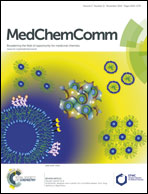Isoxazole derivatives of 6-fluoro-N-(6-methoxybenzo[d]thiazol-2-yl)benzo[d]thiazol-2-amine and N-(pyrimidin-2-yl)benzo[d]thiazol-2-amine: regulation of cell cycle and apoptosis by p53 activation via mitochondrial-dependent pathways†
Abstract
A series of isoxazole derivatives of 6-fluoro-N-(6-methoxybenzo[d]thiazol-2-yl)benzo[d]thiazol-2-amine and N-(pyrimidin-2-yl)benzo[d]thiazol-2-amine were synthesized and evaluated for their cytotoxicity. These compounds exhibited anti-cancer activity against Colo205, U937, MCF7 and A549 cancer cell lines and were more effective against the Colo205 cell line, with IC50 values ranging from 5.04–13 μM, than against other cell lines. The detailed effects of one of the promising compounds, 20c, on the biological properties of the Colo205 cell line were studied. Interestingly, compound 20c induced G2/M cell cycle arrest. The levels of p53 increased tremendously in 20c-treated Colo205 cells. The balance in levels of key mitochondrial proteins such as Bcl-2 and Bax was altered, which resulted in apoptosis by accelerating the expression of caspases. Thus, compound 20c can be considered as a potential small-molecule activator of p53, which regulates the equilibrium between rapid cell proliferation and apoptosis, and can be considered as a potential plausible candidate for further biological testing in in vivo colon cancer models.
![Graphical abstract: Isoxazole derivatives of 6-fluoro-N-(6-methoxybenzo[d]thiazol-2-yl)benzo[d]thiazol-2-amine and N-(pyrimidin-2-yl)benzo[d]thiazol-2-amine: regulation of cell cycle and apoptosis by p53 activation via mitochondrial-dependent pathways](/en/Image/Get?imageInfo.ImageType=GA&imageInfo.ImageIdentifier.ManuscriptID=C4MD00279B&imageInfo.ImageIdentifier.Year=2014)

 Please wait while we load your content...
Please wait while we load your content...